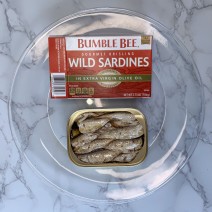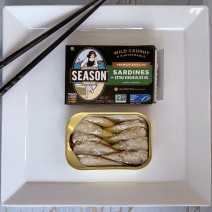What's the Best Substitute for Canned Tuna?
While many types of tinned fish and seafood, including sardines, are only recently seeing a resurgence in popularity in the Western world, most people have probably eaten canned tuna at least once in their life. For many, canned tuna fish has been a convenient and affordable source of protein and other nutrients for many years. However, recent scientific research has shown that eating many types of seafood, including tuna, may come with potential health risks including contamination with the neurotoxin mercury as well as other heavy metals and microplastics in our lakes and oceans.
Does this mean you have to give up your tuna salad sandwich for good? Fear not! Sardines are a healthy and delicious alternative to tuna as a lunchtime staple or protein-packed snack, as they are generally comparable in terms of taste and nutrition, but with less risk!
Sardines Vs. Tuna Nutrition
On the whole, canned sardines are quite similar nutritionally to canned tuna. However, they do differ in certain areas. On average, a can of sardines provides 18 grams of protein (33% DV), while an equivalent serving of tuna provides around 24 grams (44% DV). Both sardines and tuna are good sources of protein, but sardines are an even better source of omega-3 fatty acids. An average serving of sardines provides 1750 mg of omega-3’s, while a serving of tuna offers only 750 mg.
Sardines are also superior to canned tuna in their calcium and vitamin E content—an average serving provides 182 mg of calcium (14% DV) and 1.75 mg of vitamin E (8% DV), while a serving of tuna contains only 11 mg of calcium (1% DV) and .75 mg of vitamin E (3% DV).
The Vitamin K content in canned tuna does exceed that in canned sardines—with about 32 micrograms per serving (27% DV) vs just 2 micrograms (2% DV) in sardines. Vitamin K is important for blood clotting as well as bone and cartilage health, and while sardines contain less you can still get this important vitamin by eating green leafy vegetables like kale, cabbage, spinach, and broccoli and through easy-to-find supplements.
Mercury
When mercury enters the water, it is absorbed by bacteria which convert it to methylmercury, which is easily absorbable by fish and by humans. As this contaminant moves up the food chain, it accumulates in high concentrations in larger predatory fish, including tuna. Mercury cannot easily be detected in seafood, nor can it be removed from the fish before consumption. You may wonder, is mercury really harmful to everyone? Unfortunately, yes. Mercury is extremely toxic, and is especially dangerous to women who are pregnant or may become pregnant and to children. If you’d like to enjoy seafood while avoiding mercury as much as possible, choose small fish at the bottom of the food chain such as anchovies, herring, and sardines. Filter feeders like clams, oysters, and mussels are also good low-mercury options!
If you’d still like to have canned tuna once in a while, stick to chunk light rather than albacore, as it contains less mercury and is able to be enjoyed more frequently. For more information about the mercury levels in seafood and eating recommendations, check out this handy guide from the NRDC!
Microplastics
Similar to mercury, microplastics are another contaminant which accumulates in water and, subsequently, fish and other animals. It is not yet known the extent to which consumption of microplastics is dangerous to humans, but it is highly likely that it, like mercury, has neurotoxic effects, as well as contributing to endocrine disruption, thyroid damage, and cancer. Although microplastic contamination is more widespread in wild-caught seafood, microplastics have also been found in farmed seafood. So, how can you avoid microplastics in seafood? The answer is the same—reach for small fish (like sardines) and filter feeders, rather than larger fish like tuna.
Taste and Texture
No matter how healthy something is, it doesn’t make a difference unless you’re willing to eat it! Fortunately, canned sardines are not only healthier than canned tuna, but just as tasty (if not tastier) and can easily be used to prepare dishes in the same ways. Sardines come in an abundance of different sizes, tastes, and textures—if you’d like to ease your way into it, or you just prefer the drier, flakier quality of tuna, try a boneless and skinless variety. There are also more traditionally-prepared canned sardines which do have a remarkably similar smell, taste, and texture. When prepared with other ingredients (like a tuna salad style recipe or spread) even softer, fattier types of sardines will likely be indistinguishable from canned tuna. Some sardines are actually less fishy in smell and taste than tuna, and may be preferable to pickier seafood consumers for that reason.
Whether you’re a health-conscious seafood lover or are just looking for another affordable and convenient snack, canned sardines are the best substitute for tuna!



